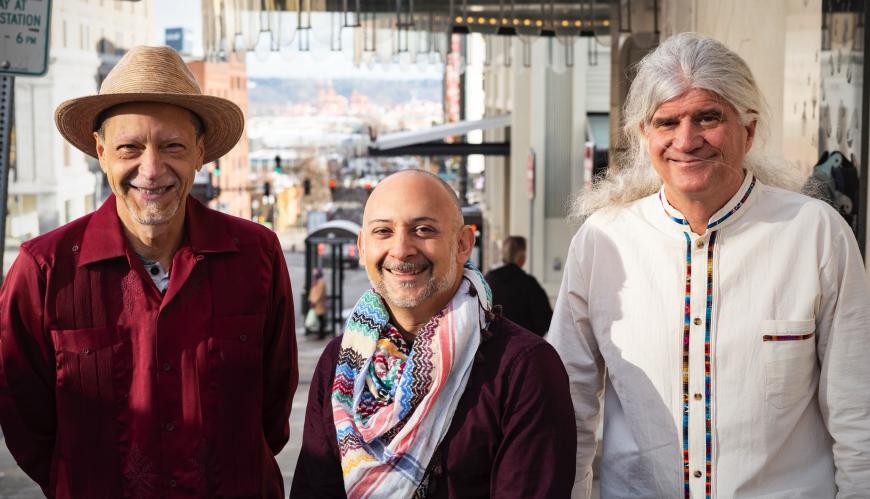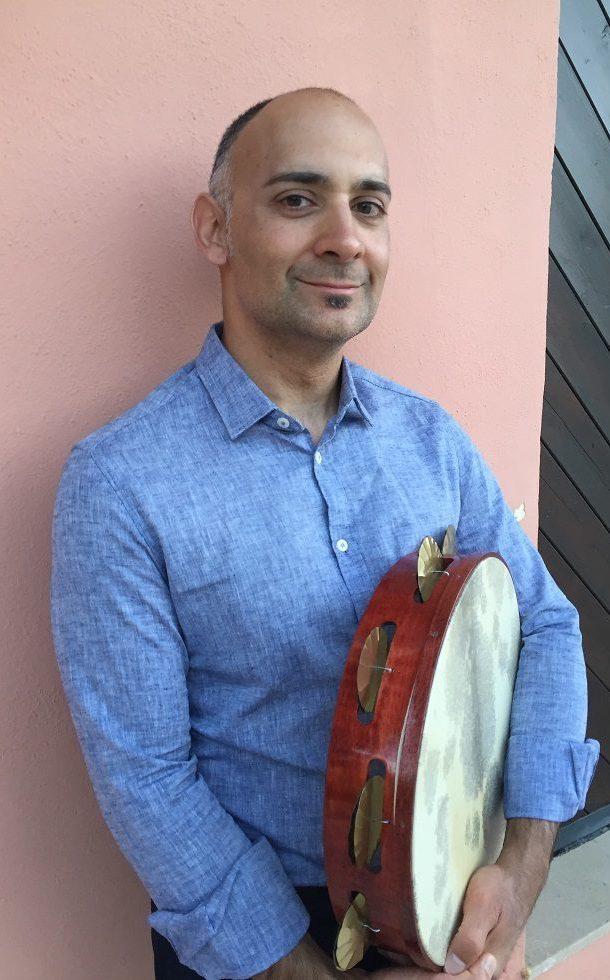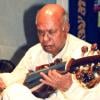
Antonio Gómez doesn’t exactly bristle when he hears Trío Guadalevín described as an early-music ensemble, but he quickly redirects the conversation and reframes the perspective.
“The only reason we call it ‘early’ is from our reference point. It wasn’t early to the people who performed it. It was music,” Gómez said on a recent video call with Guadalevín string wizard Gus Denhard. The Puget Sound-based ensemble with Abel Rocha makes its Bay Area debut on June 16 at St. Mark’s Episcopal Church as part of the Berkeley Festival and Exhibition (BFX). While the festival is produced by the San Francisco Early Music Society, Trío Guadalevín’s concept of early music makes time slippery and hard to pin down.
The ensemble’s program, “Echoes of Diaspora,” artfully illustrates Gómez’s hesitancy to affix Guadalevín’s music to any particular era. Rather, the group engages in “historically informed performance,” Denhard said, exploring the points of connection and currents of influence running between the Americas and the Mediterranean, a cultural sphere encompassing Southern Europe, the Maghreb, the Middle East, and West Africa.

“The idea is when we look at the story of human interaction, it’s lots of little tendrils that are winding around each other in the garden,” Gómez said. “Mexico meets the Mediterranean isn’t something traversed in one direction. There were musical ideas going back and forth. You see this with instruments and technique, like the cajón, which moved from Afro-Peruvian music to flamenco to pop. We’re peeling the onion and seeing the flavors that are there.”
Since coming together in 2014, the triumvirate has honed a repertoire steeped in archival research but shaped by the players’ contemporary identities and interests. Rocha is a Mexico City-born folklorist, singer, and multi-instrumentalist who is known for his expertise in music from Mexico, Venezuela, Peru, Chile, and Argentina. Before he co-founded Guadalevín, he performed widely with Correo Aereo, his long-running pan-Latin duo with multi-instrumentalist Madeleine Sosin, and Los Flacos, a quartet focusing on folkloric music of Mexico and South America.
Contributing on lute, theorbo, and Baroque guitar, the conservatory-trained Denhard has performed with many ensembles focusing on early music. Immersing himself in the Guadalevín repertoire has meant “learning rhythmic structures I’ve never been introduced to before,” he said. “Which makes me wonder why I’m learning stuff [now that] I could have gotten in school. This is definitely the right place for me.”
A percussionist who focuses on Afro-Latin and Mediterranean traditions, Gómez also works with Tango del Cielo and Pacific MusicWorks, in addition to curating the online program Deep Roots, New Branches for Early Music Seattle. Born in South Texas to a Chicano activist dad and an Italian American mom, he’s a former Bay Area resident who earned a master’s degree from UC Berkeley.
In many ways, Guadalevín’s music is shaped by the interplay of the players’ identities and the connections or voids that come about when accessing Indigenous cultures. “The way I’m going to approach rep from Mexico and Spain will be informed by my identity, that sense of heritage and those parts of my history that aren’t even available to me,” Gómez said. “What does it mean to sit with that sense of omission? Our music can be love letters to these repertoires and cultures and traditions, but we can use music to ask questions, too.”
Guadalevín is also involved in the “Caima Yyai Jesus” BFX concert on June 15 at St. Mark’s, a fascinating project exploring Renaissance and Baroque music gleaned from vast collections of manuscripts in Bolivia’s Chiquitos and Moxos archives and from Peru’s Codex Martínez Compañón. Montreal violinist Karin Cuéllar Rendón has designed a program showcasing performance practices and repertoire that emerged from the evangelization that took place in Jesuit and Franciscan missions in South America during Spanish rule from the 16th through the 19th centuries.
In addition to Guadalevín, that concert features tenor David Kurtenbach Rivera, violinist Cynthia Keiko Black, cellist Eva Lymenstull, and multi-instrumentalist Ellis Montes on recorder, pipe, and tabor. Like much of Guadalevín’s repertoire, “what the music tells us is this syncretism [amalgamation of different cultures] was in full effect,” Gómez said. “We see this with the interplay of aesthetics, and it’s confirmed in the Codex documentation of musicians in the watercolors, where you see lute, harp, quijada — the donkey-jaw percussion — and cajita — an alms box. You also see this process of sorting various cultural elements right in the music.”


